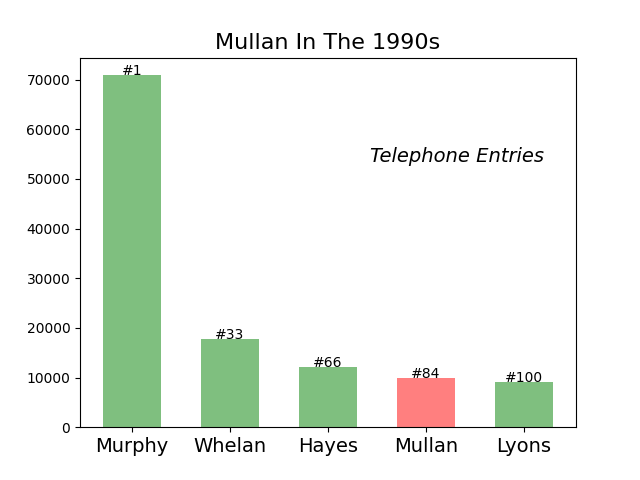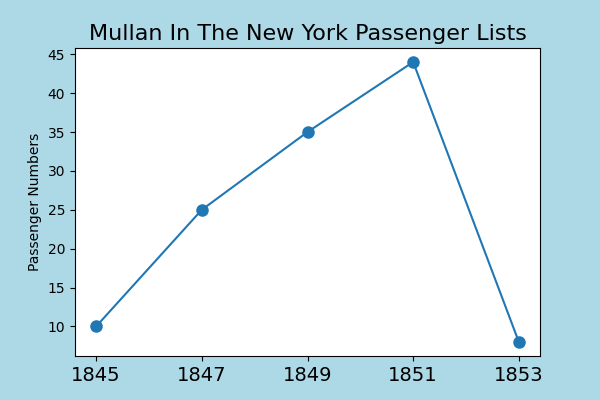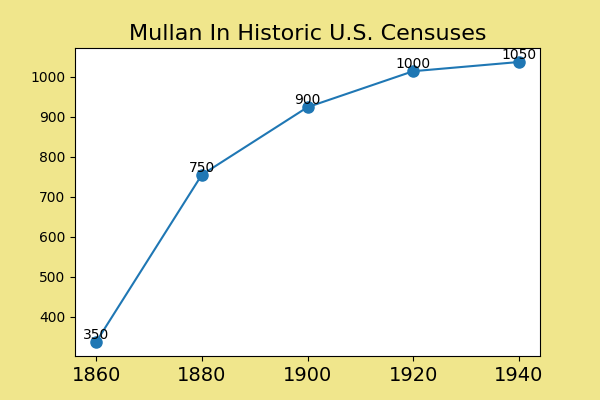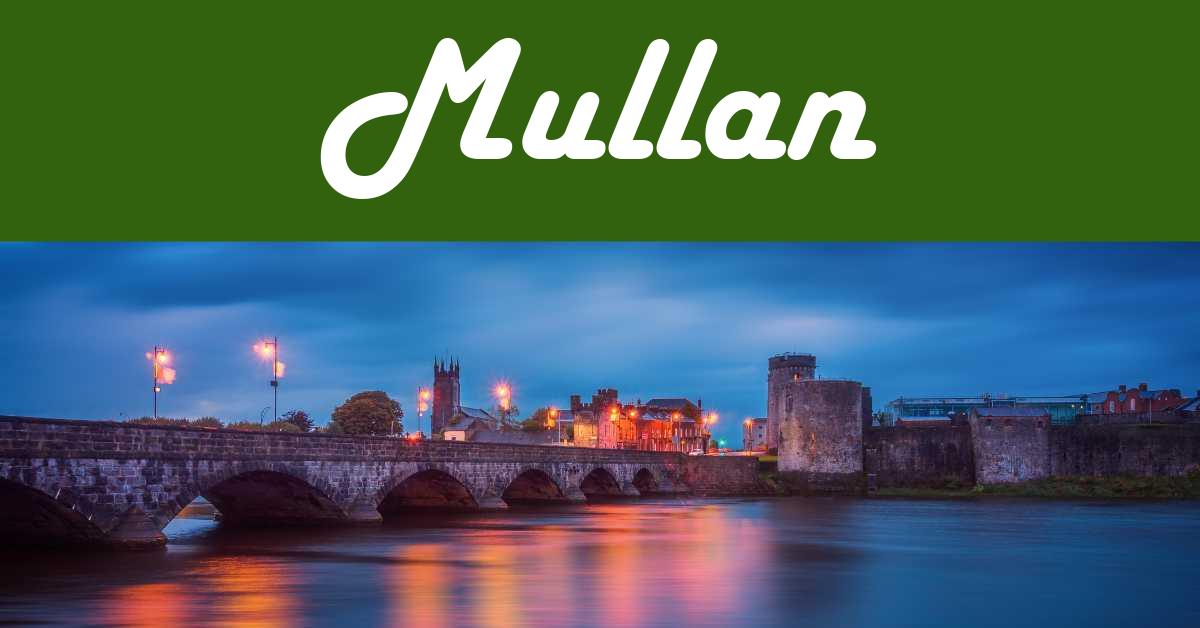This article looks at how common Mullan is as a last name in Ireland and the United States from the 19th century to the present day.
You’ll learn the meaning and origins of the Mullan surname while exploring some notable and famous people that held it.
I use census records, emigration lists, and military archives to uncover fascinating patterns. If you’re studying your genealogy, check out my sources at the end of the post so you can do your own research.
How Common Is Mullan As A Surname In Ireland?
The Irish government doesn’t publish detailed surname statistics for recent years. The best that they give us is the ten most common surnames of babies born in the previous year. Mullan
Thankfully, an Irish genealogist named Seán Murphy studied the names in national phone books published in the 1990s. His estimates aren’t as accurate as a census, but they are still a good way to get an estimate of numbers.
Mullan was ranked 84 in the top one hundred names in this decade with a total of 10,000 entries.
This graphic shows how it ranks compared to the 1st, 33rd, 66th, and 100th entries in the survey:

Mullan In The Early 1900s
The only complete Irish censuses that are available to the general public are those from the years 1901 and 1911. They offer two detailed snapshots of the population.
So, let’s concentrate on the early decades of the twentieth century.
I used online archives to calculate the total numbers by surname. I consider these estimates due to some percentage of transcription errors. So, I’ve rounded the numbers to the nearest fifty.
There were 8,500 residents named Mullan on the island in 1911.
Ten years earlier, Mullan had about 3,800 residents in the 1901 census.
Population Estimates In The 1890s
A study of Irish surnames was conducted in 1890 by the head of the Civil Registrations Office. It was published as a “Special Report on Surnames In Ireland.”
The survey estimated that there were about 9,800 people named Mullan in the country.
Emigration To America After The Irish Famine
The Irish have historically emigrated to Britain, the United States, Canada, and Australia. They were motivated by multiple factors, including social unrest, economic desperation, and hunger.
The Great Irish Famine, which happened from 1845 to 1852, caused the largest wave of emigration. The potato blight was a disaster for Ireland because it destroyed the main food source for a large proportion of the people.
I reviewed the Mullan name in the shipping passenger lists arriving in New York during this period. The departures were from both Ireland and England.
This picture shows how the numbers rose and fell in the years after the famine:

How Common Is Mullan As A Last Name In The U.S.?
Based on the 2010 U.S. census, the name Mullan ranks about 31,656 among Irish names in America with 2,034 bearers.
Although the 2010 census has exact numbers and rankings, the rank I assign here is my estimate. If you’re curious about how I got there, here’s a brief explanation…
Estimating Rank In The United States
Historically, some Irish families with Gaelic surnames took English-sounding names as translations under the influence of colonization.
As these names also have English origins, they will have been brought to the United States by both British and Irish immigrants. Because the census doesn’t ask about specific European origin (e.g. England vs Ireland), it’s impossible to identify the proportion with Irish heritage.
I reviewed the census to identify which names are predominantly Irish in origin. In order to estimate the relative rankings of “Irish” names, I’ve mostly excluded surnames that have varying origins.
Mullan In Historic Times
In a country as young as the United States, tracking the popularity of a surname over time can be fascinating. This reflects other demographic shifts across the country in addition to immigration. Higher child mortality rates and longer life expectancy are just two factors.
The historic census records have been transcribed and digitized. I used online archives to run counts of surname populations.
But the totals can’t be exactly accurate due to transcription errors. So, I’ve rounded the numbers to the nearest 50 in the graph below.
This picture shows the numbers every twenty years from 1860 to 1940:

These are the numbers in the graph:
- 1860: 350
- 1880: 750
- 1900: 900
- 1920: 1,000
- 1940: 1,050
Mullan In World War II
About 8.3 million men and women enlisted in the U.S. Army during the Second World War. Many were of Irish heritage, and some were born in Ireland.
There were registration records for 64 soldiers named Mullan who enlisted between 1938 and 1946.
There were 7 who were born in Ireland.
Mullan Surname: Meaning And Origin
Mullan comes from the Gaelic “Ó Maoláin”, which means “descendant of Maolán”.
The personal name Maolán is a diminutive (pet) form of the word “maol”, which means “bald”. So, the full name means “descendant of the bald person.”
One of the early powerful families was in County Derry in Ulster.
Famous Or Historic People Named Mullan
Here are some notable people with the family name:
- John Mullan (1830 – 1909): an American explorer, the Mullan Pass in the Rocky Mountains is named after him.
- Charles Mullan (1845 – 1919): American attorney who served as Attorney General in Iowa for six years before becoming a district court judge.
- John B. Mullan (1863 – 1955): a New York senator who brought in the short-lived Mullan-Gage Act for prohibition with his fellow senator Bert Gage.
Sources

External Research
The Ireland 1990s estimates are from Seán J. Murphy’s research paper.
The population estimates of 1890 are based on the “Special Report on Surnames in Ireland“, published in 1909.
The population figures for the 2010 U.S. Census come from a file provided by the U.S. Census Bureau.
Internal Research
Some of the population numbers are based on my own research and calculations using online archives. I’ve rounded those numbers to the nearest 50 to account for transcription errors and other technical issues with online databases of this type.
The Irish census estimates for 1901 and 1911 are my calculations based on the Irish National Archives
I plotted the emigration figures from 1845 to 1854 based on calculations from the archives of the New York Passenger Lists (1820-1957).